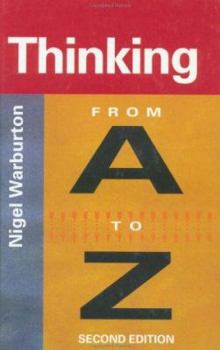Thinking from A to Z
Select Format
Select Condition 
Book Overview
What is 'humpty-dumptying'? Do 'arguments from analogy' ever stand up? How do I know when someone is using 'weasel words'? What's the difference between a 'red herring' and a 'straw man'?This superb... This description may be from another edition of this product.
Format:Paperback
Language:English
ISBN:0415222818
ISBN13:9780415222815
Release Date:June 2000
Publisher:Routledge
Length:164 Pages
Weight:0.46 lbs.
Dimensions:0.5" x 5.1" x 7.8"
Customer Reviews
5 ratings
Concise wisdom
Published by Thriftbooks.com User , 18 years ago
I found "Thinking from A to Z" to be a concise, and well laid-out explanation of the logical terms in classical arguments. It paid off handsomely in a recent college class, providing explanations for each of the classical elements of logical argumental.
I wish I had read this book 25 years ago...
Published by Thriftbooks.com User , 20 years ago
If I had read this book 25 years ago, I would have saved myself the confusions and frustrations of spending a great deal of time and effort trying to make sense of certain "New Age" authors whose pretentions were only matched by their (now obvious) lack of clear reasoning ability. This book is short and easy to read and understand, and its concepts are essential for avoiding the kinds of distortions and lies which are unfortunately so highly prevalent in any open society. Free speech is great, but we must all arm ourselves against the people who want to take advantage of our willingness to give other points of view the benefit of our doubts.
The ABC's of Analysis and Argumentation
Published by Thriftbooks.com User , 22 years ago
I believe it was P.T. Barnum who said "You'll never go broke underestimating the public." Barnum was speaking hyperbolically (I hope), but it is true that many otherwise intelligent people will fall prey to the most outlandish fraud and manipulation. In addition to protecting the reader against conmen, this little book will serve as an antidote to fuzzy thinking in general."Thinking" is set up like a dictionary, with alphabetical entries and boldfaced cross references. This arrangement makes the work somewhat user-unfriendly. You can't analyze an argument by looking it up in the book. You won't know what entry to look under. Reading the book straight through from A to Z makes the presentation somewhat disjointed because related ideas are scattered throughout the book depending on what letter of the alphabet they begin with.A good way to attack the book is to start at A and read the entries in alphabetical order, stopping to look up and read each cross reference as you come to it. Thus you'd read "Absurd consequences move" first, and then skip to "reductio ad absurdum," "refutation," and the other terms cross referenced in the entry. Then you'd read the next alphabetical entry and all its cross references, and so on until you come to the end of the book. If you follow this procedure with each alphabetical entry, re-reading every term each time it is cross referenced, by the time you get to "Zig-zagging," you will have a good handle on all types of logical and illogical arguments. You'll also be able to analytically dissect advertisements, newscasts, op-ed pieces, and political speeches."Thinking," gives an excellent grounding in rhetorical analysis that will serve you well the next time someone tries to pull the wool over your eyes.
More than Just a Glorified Glossary
Published by Thriftbooks.com User , 23 years ago
Being able to spot poor reasoning and diversionary tactics such as fallacies, gobbledegook, jargon, pseudo-profundity and smokescreens will put more clout behind your arguments and sharpen your thinking. As an introduction to critical thinking, this delightfully concise little book provides some of the basic tools for clear thinking on any issue. The techniques and topics discussed are transferable and can be applied to any area in which clear thought is required: they have direct applications in most academic disciplines and in any facet of life in which people present reasons and evidence in support of conclusions.Now in its second edition, this book is a set text for the Open University A211 Philosophy and the Human Situation course. It will give you the power to tell a good from a bad argument. Using witty and topical examples, author Nigel Warburton will enable you to distinguish with confidence between a red herring and a straw man. This new edition updates the whole text and includes many new entries, all listed in alphabetical order. However, the next edition should include the following suggested entries: * ergo et sum * I think, therefore I am * Rene Descartes * logic * Betrand Russell * lateral thinking * Six Thinking Hats * tautologyNigel Warburton is the author of Philosophy: The Basics, Philosophy: The Classics, and editor of Philosophy: Basic Readings (all published by Routledge).
Excellent and concise!
Published by Thriftbooks.com User , 24 years ago
It succinctly explains generally the aspects of argument. What is modus ponnens or afirming the antecedent? How do you recognize the gamblers fallacy? It is in alphabetical order with the various subjects explained in the most simple terms possible, with many helpful examples. Well worth the price.




